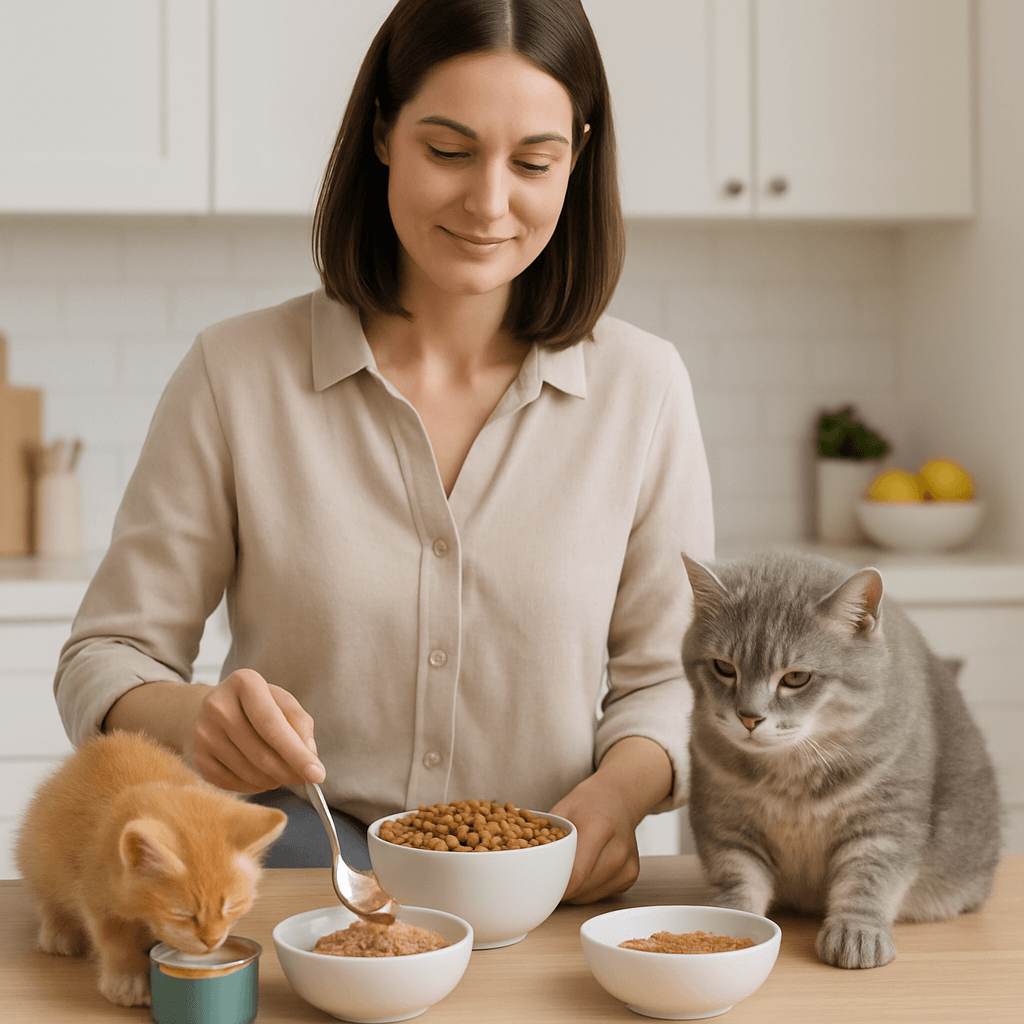Choosing the best cat food by age is an important part of keeping your furry friend healthy and active. Cats have different nutritional needs at different stages of life—kitten, adult, and senior. The right food supports their growth, energy levels, and overall well-being. Feeding your cat properly can help them live a longer, happier life.
Understanding Your Cat’s Nutritional Needs by Life Stage
Just like humans, cats go through life stages that require different kinds of nutrition. The three main stages are:
- Kitten (0-12 months): Needs a calorie-rich diet with more protein and fat to support rapid growth and energy demands.
- Adult (1-6 years): Requires a balanced diet that maintains health and energy levels without leading to weight gain.
- Senior (7+ years): Needs fewer calories but more nutrients like fiber and joint support ingredients to manage aging.
Best Cat Foods for Kittens
Kittens need food designed for growth and development. Look for formulas that contain high protein, essential fatty acids like DHA, and other vital nutrients.
- Hill’s Science Diet Kitten: Made with real chicken and packed with DHA from fish oil for brain and vision development. Price: About $20 for a 7 lb bag.
- Blue Buffalo Healthy Growth Kitten: Grain-free, high in protein, and includes LifeSource Bits—a blend of nutrients and antioxidants. Price: Around $22 for a 7 lb bag.
- Purina Pro Plan Kitten: Contains real chicken, vitamins like A and E, and omega-6 for skin health. Price: Approximately $18 for a 6 lb bag.
Benefits: Helps bones and muscles develop, improves immune system function, and provides the energy kittens need to play and grow.
Best Cat Foods for Adult Cats
Adult cats need maintenance diets that give them steady energy and help prevent obesity. The best foods have the right blend of protein, fiber, and limited fat.
- Royal Canin Indoor Adult: Specifically made for indoor cats to support digestive health and reduce hairballs. Price: Around $45 for a 15 lb bag.
- Wellness Complete Health: A natural recipe with real salmon and vitamins to support healthy skin, coat, and energy levels. Price: Approximately $35 for a 12 lb bag.
- Iams ProActive Health Adult: Good balance of nutrients with prebiotics for digestion. Budget-friendly. Price: About $17 for a 16 lb bag.
Benefits: Maintains ideal body weight, supports muscle tone, and improves coat condition and digestive health.
Best Cat Foods for Senior Cats
Senior cats often deal with slower metabolism and health issues like arthritis or dental problems. Their food should be softer and provide nutrients for aging joints and organs.
- Nutro Wholesome Essentials Senior: Made with real chicken and brown rice; includes omega-3 for joint health. Price: About $30 for a 14 lb bag.
- Purina ONE Vibrant Maturity: Offers brain health support and easy-to-digest formulas. Comes with antioxidants and vitamins. Price: Around $20 for a 16 lb bag.
- Blue Buffalo Health Aging: Features LifeSource Bits, taurine for heart health, and controlled calories. Price: About $35 for a 12 lb bag.
Benefits: Supports joint function, improves cognitive abilities, and addresses weight management while protecting internal organs.
Dry vs Wet Cat Food: Which is Better?
Whether you feed your cat dry or wet food often depends on their age, health, and preference. Each type has its advantages:
Dry Food (Kibble)
- More affordable and easier to store.
- Can help clean teeth due to its texture.
- Often longer shelf life once opened.
Wet Food (Canned or Pouched)
- Higher moisture content, helpful for cats prone to urinary problems.
- Easier to chew for older cats or those with dental issues.
- Often more appealing to picky eaters.
Some cat owners choose a mix of both to offer balanced nutrition and advantages from each type.
How Pricing Varies With Cat Foods
The cost of cat food depends on brand, ingredients, and the life stage it’s designed for. Generally, kitten food is a little more expensive due to its high-protein content and added nutrients. Adult foods offer more pricing options, and senior foods may cost more because of special ingredients for aging cats.
- Budget brands: $15–$20 for a 15 lb bag (like Iams or Purina One)
- Mid-range: $20–$35 for a 12–15 lb bag (like Blue Buffalo or Nutro)
- Premium brands: $40 and up (like Royal Canin or Hill's Science Diet)
Tips for Choosing the Right Food for Your Cat
- Always check for an AAFCO (Association of American Feed Control Officials) statement indicating the food meets nutritional standards.
- Try to find food with meat listed as the first ingredient for better protein quality.
- Stay away from foods with artificial fillers, chemical preservatives, or unnamed “meat by-products.”
- Ask your vet for advice if your cat has allergies, stomach sensitivity, or chronic illness.
- Monitor your cat’s weight and activity level to adjust feeding portions or switch to a different recipe if needed.
Conclusion: Feed Your Cat According to Their Age for Optimal Health
Feeding your cat based on their age can make a significant difference in their health and happiness. Kittens need high-protein diets that support rapid growth, adults require balanced formulas for long-term maintenance, and seniors benefit from food that supports joint and heart health. Whether you choose dry, wet, or a combination of both, the right diet helps your cat live a fuller, longer life. Compare ingredient labels, price points, and your cat’s health needs to find the food that works best for your situation.
Sources:
- American Association of Feed Control Officials (AAFCO) Nutritional Standards
- “Kitten Nutrition Guide” – PetMD
- “Choosing the Best Cat Food by Life Stage” – The Spruce Pets
- National Research Council: Nutrient Requirements of Cats
